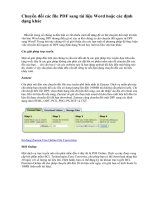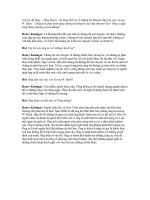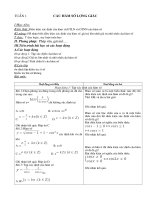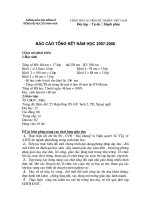Tài liệu 2012 Economics Higher Finalised Marking Instructions doc
Bạn đang xem bản rút gọn của tài liệu. Xem và tải ngay bản đầy đủ của tài liệu tại đây (292.08 KB, 17 trang )
©
2012 Economics
Higher
Finalised Marking Instructions
Scottish Qualifications Authority 2012
The information in this publication may be reproduced to support SQA qualifications only on a
non-commercial basis. If it is to be used for any other purposes written permission must be
obtained from SQA’s NQ Delivery: Exam Operations.
Where the publication includes materials from sources other than SQA (secondary copyright),
this material should only be reproduced for the purposes of examination or assessment. If it
needs to be reproduced for any other purpose it is the centre’s responsibility to obtain the
necessary copyright clearance. SQA’s NQ Delivery: Exam Operations may be able to direct
you to the secondary sources.
These Marking Instructions have been prepared by Examination Teams for use by SQA
Appointed Markers when marking External Course Assessments. This publication must not
be reproduced for commercial or trade purposes.
Page 2
Economics 2012
Higher
SECTION A
ITEM A
Marks
(a)
Define the following terms, as used in the passage:
(i)
“real terms”
For realising that real terms involves a comparison with overall inflation
or price rises – one mark.
For concluding that cotton prices have become cheaper (or fallen behind)
measured against overall inflation – one mark.
2
(ii)
“profit margins”
For realising that in the context of the passage, profits must be under
threat or reducing – one mark.
For stating that profit margins represent the difference between revenue
and costs – one mark.
For defining – profit as a percentage of selling price – two marks.
Mark up (1 mark).
2
(b)
(i)
Explain one factor that makes the demand for bread piece inelastic.
Bread is an essential (or necessary) – 1 mark and as such most
consumers will continue to purchase or still buy similar amounts as the
price rises (demand falls less than proportionately) – 1 mark.
Or bread is a low value item (or a low percentage of overall spending) –
1 mark and these products tend to have low price elasticity because
overall the increase is less significant to the consumer – 1 mark.
2
(ii)
Explain how the total revenue of bread producers will be affected by the
increase in the price of bread.
Total revenue will increase – 1 mark
For a price inelastic product, the increase in revenue due to the price
increase exceeds any loss of income from falling sales. Therefore the
total revenue increases – 2 marks.
2
(c)
Draw one diagram to show how both production problems and China’s
economic growth could cause a change in the price of copper.
1 mark for axes.
For ss1 moving leftwards to ss2 (production problems) – one mark.
For dd1 moving rightwards to dd2 (increased demand from China) – one mark.
For indicating clearly the upward movement in equilibrium price – one mark.
Maximum of 2 marks if one of the curves is incorrect.
3
Page 3
(d)
Explain how the price of China’s imports of raw materials would be affected if
the exchange rate of China’s currency were to rise.
The rising exchange rate will decrease the price of China’s imports – one mark,
and an explanation of how, far one further mark – one mark.
Candidates may use two different values for the currency and give a simple
arithmetic proof of the fall in price in Yuan. This approach would be worthy of
two marks.
2
(e)
Explain one factor that will affect the price elasticity of supply of copper.
Most candidates will highlight the problems of increasing production in the
short run and with some development (eg saying this will cause inelastic price
elasticity of supply) this is worth two marks. Examples: the availability of the
resource; the length of the production period; the unavailability of spare
capacity; the lack of stock in reserve; the time it takes to move capital into the
copper industry.
2
(f)
(i)
Draw a diagram to show how guaranteed minimum prices to cotton
farmers in the USA can lead to the overproduction of cotton.
For showing a guaranteed minimum price above market equilibrium –
one mark.
For indicating the gap between supply and demand at this price as a
glut/surplus or over-supply and using one of these terms (or in some
other way making it apparent that supply exceeds demand) – one mark.
2
(ii)
Suggest 2 trade barriers that can be used to reduce imports and explain
how they would work.
Suggestions for one mark each (max 2) include: tariffs, quotas,
subsidies, embargos, exchange controls, preferential purchases of home
products, administrative delays, bogus health and safety issues etc –
one mark.
Definitions – 1 mark only
Further one mark for each brief explanation of how they might work – so
2 suggestions and 2 explanations for 4 marks.
4
(g)
Explain 2 measures that companies such as Primark and Next could take to
maintain profit margins without increasing retail prices.
Suggestions for one mark each with a further mark for development may
include: fewer staff, more mechanisation, less waste, seeking to reduce
transport costs, seeking to make savings in stockholding, greater economies
of scale; merges/take-overs to cut average costs; opening longer hours;
delayering management.
Selling more units (1 mark) with no corresponding increase in costs (1 mark).
4
(25)
Page 4
ITEM B
Marks
1
(a)
Explain the following terms, as used in the passage:
(i)
“budget”
Annual statement of the Scottish Government’s spending plans (2).
Credit reference to constraints on Scottish Budget and do not
penalise reference to taxation.
Plan of Government spending (1 mark)
Reference to either Scotland or austerity (1 mark)
2
(ii)
“downsizing of the Scottish State”
Cuts in government spending – 1 mark
A significant decrease in the size and influence of the public sector
in Scotland (2) or a fall in the size of the public sector as a
percentage of Scottish GDP (2). Credit reference that the Public
Sector accounts for 50% Scottish GDP.
2
(b)
Explain how flexible working practices can reduce the effects of budget
cuts on employment
Flexible working practices such as part-time working allow more people
to keep their jobs as workload is spread. Up to 2 marks for point and
explanation.
Flexible working practices lowers labour unit cost so reduces labour costs
and therefore maintains the numbers employed. Up to 2 marks for point
and explanation.
Flexible working practices raise productivity and lowers unit cost. Up to 2
marks for point and explanation.
Accept answers which refer to flexible labour markets increasing demand
for labour.
No ID marks.
2
(c)
Describe how the UK Government measures the rate of inflation.
Inflation is measured monthly (1) using an index of the price of 600/700
goods and services which are collected at various locations around the
UK (1). The items are chosen to reflect the spending of the average
household (1). The items are weighted to reflect their significance as a
proportion of total household spending (1). The index starts at a Base
Year from which changes in the price level are compared (1).
Credit comparisons of RPI and CPI
No ID marks
3
Page 5
(d)
Explain what impact the cuts in Higher and Further Education may have
on the Scottish Economy in the future.
Future shortage of skilled labour (1) could lead to higher unemployment
(1) or lower productivity (1). Max 2 marks for point and explanation. This
would lead to lower economic growth than might have been (1).
Scotland may attract less FDI (1) and therefore will have higher
unemployment and lower economic growth (1).
Scotland may miss out on future technology developments due to lack of
a skilled workforce (2).
Credit reference to the effects of future higher unemployment on the
government finances.
4
(e)
Explain the measures the Chancellor of the UK could take to “support
and encourage small and medium sized businesses”.
One mark for point and one mark for development.
Lower tax rates for small businesses.
Subsidies.
Encourage Bank Lending at lower rates.
Grants for new businesses.
Training schemes for those who want to set up a business.
At least 2 points for full marks. Credit other relevant points.
3
(f)
Explain how cutting the budget deficit might conflict with 2 other
government economic objectives.
1 mark for the objective and 1 mark for explaining why the conflict arises.
Low unemployment.
High Economic Growth.
Lower Inequality.
Meeting the inflation target.
4
(g)
(i)
Suggest 3 reasons why foreign firms might decide to locate in
Scotland.
1 mark per point.
Lower wages
Skilled labour force.
Government assistance.
Good Infrastructure.
Access to EU markets.
Good cultural events, education system, etc.
3
(ii)
Explain one possible disadvantage of this foreign investment to the
Scottish Economy.
1 mark for the point and 1 mark for the explanation.
Repatriation of Profits.
Reliance on foreign firm who may lack loyalty.
Top jobs may go to employees from abroad.
‘Screwdriver’ economy
Credit any other relevant point and explanation.
2
(25)
Page 6
SECTION B
Marks
1
Economics has been described as the study of choice.
(a)
Explain why the basic economic problem means that choices will always
have to be made by individuals, firms and the government.
Max 3 marks on scarcity (include a definition of opportunity cost)
Up to 2 points for each cause of a choice with development (individuals/
firms/government)
Candidates should set out what is meant by the basic economic problem.
1 mark only for stating consumers unlimited wants/limited resources.
Choices are caused by limited incomes/limited profits/limited government
tax revenues.
7
(b)
Explain using production possibility diagrams:
(i)
productive efficiency
For all aspects of drawing and labelling the diagram – one mark.
For stating that all points on the curve are points of maximum
efficiency – one mark, ie maximum potential output if all resources
fully utilized.
For stating that points inside the curve are inefficient – one mark.
For stating that points beyond the curve are unreachable with
present technology – one mark.
Credit explanation.
Maximum 4 marks.
(ii)
opportunity cost
The diagram will show:
Max 2 marks for accurately demonstrating opportunity cost on a
PPC.
1 mark for explaining the output lost of one good if more of the other
is produced.
1 mark for definition of opportunity cost or description of a good
being sacrificed.
1 mark for explanation of concave line.
Maximum 4 marks
8
Page 7
(c)
Explain how fiscal policies and the multiplier effects can be used to
increase national income.
Look for an explanation of how an increase in government spending (1)
injects money into the circular flow (1). The answer can also be
developed by explaining that the government will employ additional
workers directly (1), or that by placing contracts with private companies,
these companies will need extra workers (1) to deliver roads/railways or
other example (1). Other possible answers, such as higher public sector
pay should also be credited. Candidates should not be given any marks
for rounding off their answer to the effect that this will increase production
– that is in the question – five marks.
Look for an explanation of how a decrease in taxation (1) reduces
leakages/withdrawals from the circular flow (1). The answer can also be
developed by explaining that cutting income tax leaves higher net pay
which consumers then spend (1), leading to increased demand for goods
and services in the shops (1) resulting in larger orders to factories thus
driving up production (1). Cuts in VAT or other consumption taxes leave
consumers with greater purchasing power and stimulate production in the
same way – five marks.
Credit an accurate multiplier equation 1/MPS or 1/1-MPC. Credit an
understanding that the economy is affected by a greater amount than the
initial injection. Credit references to the number of additional jobs and
incomes credited. Up to 3 development marks for: explaining how one
person’s spending finds its way into another’s income and is spent again,
and so on; and for explaining the significance of the size of the multiplier
to the size of the outcome – five marks.
Up to 5 for each section of the answer, so 4:4:2 would give full marks
of 10.
Max 8 marks on a purely descriptively
10
(25)
Page 8
Marks
2
Following a recession, the UK economy experienced a period of low interest
rates in 2010.
(a)
(i)
Explain what is meant by a “recession”.
For a definition of two successive quarters of negative economic
growth (2) or other similarly worded responses – two marks.
For making it clear the output GDP of the UK economy has reduced
(or unemployment risks) – one mark.
2
(ii)
Describe the possible consequences of a recession for individuals,
firms and government.
One mark per point.
There are many consequences that candidates may choose to write
about. Here are some of the most likely but mark any appropriate
response. A maximum of 3 marks for the development of each idea.
Candidates may have less development and more ideas. Some
answers overlap and judgement will be needed to mark on overall
quality.
Individuals – Rising unemployment and the various consequences
eg – falling living standards/income; loss of skills, increased poverty
etc, loss of self-esteem, family breakdown, ill-health.
Government – Falling tax revenues from income tax as the
unemployed don’t pay tax and less corporation tax as company
profits fall, and less VAT as spending by consumers reduces etc.
Increased government spending as a result of more benefits being
paid out, and the costs of helping regenerate unemployment
blackspots. Further additional costs for retraining of workers.
References to increased health spending or countering vandalism
are also valid.
Rising budget deficit (and hence the need to borrow or print money)
because of falling tax revenues and increased benefit payments.
Businesses – Business bankruptcies due to less consumer
spending; and lower prices and profit margins when “sales” are
required to unload excess stock. Need to cut costs, find new
markets abroad.
All 3 areas must be covered for 10 marks.
Max 7 if one area is excluded.
10
Page 9
(b)
Explain how monetary policies can assist an economy in returning to
economic growth.
It is not necessary to mention “quantitative easing” to obtain full marks.
Definitions should be credited, but note it should be clear that interest
rates should be reduced for the mark. There are several possible routes
to economic growth from this policy. Up to a maximum of 3 marks are
available for each development.
For decrease interest rates – one mark.
For explaining how a fall in interest rates may make investments using
borrowed money more likely as the borrowing costs are less, making
possible otherwise marginal projects. Investment is a component of AD
and will therefore lead to higher economic growth – 3 marks.
For explaining how reducing interest rates lowers the housing costs of
those paying mortgage interest, leaving them with more cash to purchase
goods and services. Increased consumption leads to increased
production and encourages investment by business – three marks.
For explaining how credit purchases are cheaper (credit cards, loans)
and this encourages more spending and less saving as the return on
saving is reduced. In turn producers have to increase output to satisfy
the demand – one mark.
For quantitative easing (or open market purchases or printing money or
increasing the money supply) – one mark.
For explaining the effect of lower interest rates on the exchange rate and
the effect on raising exports and AD (3).
For outlining any of the above and explaining how the increased
availability of credit through the banking system will encourage spending
and investment leading to economic growth.
8
(c)
Describe the possible impact on the UK economy of economic recovery
in other EU states.
Mark on overall quality but the main points are that:
These nations are the biggest customers for our exports;
Selling more exports leads to export-led growth;
Creating orders for factories in the UK;
Creating more jobs and higher output;
and further growth via the multiplier effect.
Other relevant comments may include: explaining that the export
revenues enter the UK circular flow of income as an injection and
therefore increases economic activity in the UK.
5
(25)
Page 10
Marks
3
(a)
Explain, using a diagram, what happens to a firm’s average total costs in
the short run.
ATC is U-shaped. ATC falls and then rises as output increases. (1)
The shape of the ATC curve in the SR is determined by the shape of the
AFC + AVC added together (1).
AFC falls over its entire length as a constant is spread over its entire
length (1).
AVC falls and then rises because of initially increasing returns and
ultimately diminishing returns (1
When the rise in AVC outweighs the fall in AFC then ATC will rise (1).
The diagram should have 1 mark for the ATC curve accurately depicted.
1 mark for axes correctly labelled. Diagrams which show other curves or
the optimum output can gain a maximum of 3 marks.
Full marks can be 5:2 or 4:3.
7
(b)
Explain, using examples, what is meant by internal and external
economies of scale.
Up to 2 marks for a good definition of internal economies of scale. (Up to
1 mark for an accurate diagram)
Up to 2 marks for a good definition of external economies of scale. (Up
to 1 mark for an accurate diagram).
No marks are to be given for any definition/examples of diseconomies of
scale.
Examples of Internal Economies of Scale – up to 2 marks for explaining
the economy of scale and relating the point to a fall in LRAC. No marks
should be given for just naming the type of economy of scale with no
explanation.
Types of internal economy of scale which should be credited include:
Technical, Managerial, Marketing, Financial, Managerial, Risk-bearing,
Research and Development, and any other accurate example.
Examples of External Economies of Scale – Local Colleges providing
training courses, ancillary firms and suppliers locating nearby, specialist
infrastructure, skilled local workforce lowering recruitment costs, etc.
Marks can be allocated 5:5, 4:6, 6:4.
10
Page 11
(c)
(i)
Apart from an increase in the costs of production, explain 2 other
factors which can cause an increase in the rate of inflation.
Credit straight forward explanations to the different causes of
explanation apart from Cost – push which would receive 0 marks.
Demand – Pull Inflation (1) which occurs when Aggregate Demand
is rising at a faster rate than Aggregate Supply close to full
employment (1) which puts upward pressure on prices.
Monetary Inflation (1) occurs when the money supply is growing at
a faster rate than output/AS (1). This can be caused by the
government printing money to fund government spending (1).
Accept a description of a fall in the value of the £ leading to higher
import prices.
4
(ii)
Describe how a rise in the UK rate of inflation is likely to affect the
Current Account of its Balance of Payments.
1 mark for stating that the deficit on the Current Account is likely to
worsen.
1 mark for stating that the effect depends on the UK inflation rate
compared to its major trading partners.
1 mark for stating that UK exports may become less price
competitive in foreign markets if UK firms raise their prices (1). This
may lead to a lower demand for UK exports which would fall in value
(1).
1 mark for stating that foreign imports will become relatively cheaper
in the UK (1) and therefore import volumes and values will rise (1).
Credit should be given that this effect depends on the PED for
imports and exports.
4
Page 12
Marks
4.
(a)
(i)
Explain the shape of the normal demand curve.
Up to 3 marks for a full explanation of each possibility. Two full
explanations can gain full marks.
The effect only needs to be explained in one direction for full marks.
The Income Effect (1) causes demand for a product to fall when
price rises because when the price of a good rises it becomes less
affordable (1) or it causes real income to fall making all goods less
affordable including that one so demand falls (2).
The Substitution Effect (1) – When the price of a good rises
customers may switch to cheaper substitutes (1) to maximise utility
per £ spent (1).
The Law of Diminishing Utility (1) – The law states that as more of a
good is consumed the marginal utility from consuming each
additional unit decreases (1). In order to reflect this a consumer will
only demand additional units of a good if price is lowered on
successive units (1). The individual’s demand curve is also their
marginal utility curve (1).
No diagram is required.
6
(ii)
Explain 2 reasons why some demand curves are abnormal.
1 mark for point/name and 1 mark for explanation.
Giffen Goods (1) – These are goods which are staples and when
price rises consumers buy more because they devote more of their
income to their staple food as luxuries become less affordable (1).
Credit reference to examples such as potatoes in the Irish potato
famine or rice in Asia (1).
Veblen Goods (1) – Also credit “conspicuous consumption” and
“ostentatious consumption”. These are goods who have such
status or prestige attached that demand rises as price rises (1).
Credit examples such as designer labels (1).
Speculation/Expectation of future price rises. Demand for some
goods or assets will rise if consumers expect to profit from future
price rises (1). Credit references to examples such as property,
shares, goods etc (1).
4
Page 13
(b)
Describe the factors which may cause the exchange rate of sterling to
fall.
Up to 2 marks for each fully explained point. Points can be either about
demand or supply of £s as long as accurate.
Up to 2 marks for describing that the value of £ will fall if there is a fall in
demand for £s in the foreign exchange markets (1) or an increase in
supply of £s in the foreign exchange markets (1).
Factors which lead to a fall in demand for £s – a fall in UK exports, less
foreign tourists visiting the UK, less inward hot money flows into the UK,
lower demand for UK investments/bank deposits – credit mention of
relative interest rates/investor confidence.
Factors which would lead to a rise in the supply of £s – rising imports into
the UK, more UK residents travelling abroad, speculators selling £s in
anticipation of a fall in the £. Investors shifting deposits to foreign banks.
Credit mention of relative interest rates/investor confidence.
8
(c)
Describe the likely effects on the UK economy of a fall in the exchange
rate of sterling.
Probable improvement in the Balance of Payments (1) due to an
improvement in the international competitiveness of UK Businesses (1).
This is because a lower £ should make UK exports cheaper in foreign
markets (1) and therefore the volume and value of UK exports should rise
improving the current account balance (1). The volume of imports should
fall (1) because imports become dearer in the UK and UK firms will
become more price competitive in the domestic market (1).
Falling Unemployment/Rising Employment (1) – Rising demand for UK
produced exports and at home should lead to higher demand for labour
(1). Credit term derived demand (1).
Rising Economic Growth (1) – Exports are a component of AD and rising
exports will lead to a rise in AD and economic growth (1). Credit positive
multiplier effect.
Rising Inflation (1) – Higher import prices will lead to higher prices for
producers and consumers (1). The negative effects of higher inflation on
living standards and the economy should be credited (max 2).
For full marks at least 2 points must be covered.
7
Page 14
Marks
5
(a)
Describe the theories of Absolute and Comparative Advantage.
Absolute advantage refers to a situation where some countries are more
efficient at producing some good/services and other countries are better
at producing other goods/services. Both countries should benefit if they
specialise in that good/service and trade with the other country that has
been absolute advantage in the other good/service. World output will be
greater and living standards will rise in both countries. Credit Numerical
or real life examples.
Comparative Advantage refers to the situation where some countries
have an absolute advantage in both goods/services. This theory states
that countries should specialise in that good/service where they have a
comparative advantage ie that in which they have the lowest opportunity
cost. World output will rise and living standard in both countries will rise.
Credit numerical examples.
8
(b)
Explain the main economic advantages and disadvantages to the UK of
membership of the European Union.
Advantages
Unrestricted movement of goods, services and labour among countries
Firms can achieve economies of scale.
Greater choice for consumers.
More competition encourages efficiency.
Harmonisation of standards.
Bigger market for exporters/increased volume of trade.
More employment opportunities/greater incentive to train and learn.
Less red tape ie no quotas and tariffs to administer.
Economic growth encouraged.
Cheaper supplies.
Disadvantages
Competition for UK firms.
Lower wage economies.
Migration issues.
Contributes to EU Budget.
Eurozone crisis.
Both advantages and disadvantages must be covered for full marks (6,6),
(8,4), (4,8). Up to 2 marks for each well explained point.
No ID marks
12
Page 15
(c)
Describe some of the uses of National Income statistics.
To compare with other countries.
To compare with previous years.
To calculate rate of economic growth.
To calculate money and NI per head of pop/to compare living standards.
To assess how certain areas of economy are performing eg tertiary
sector.
To identify policy successes/failures.
To highlight where government assistance is required.
To calculate UK Contribution to EU etc.
5
Page 16
Marks
6
Markets do not always allocate resources in the way that leads to the best
possible outcomes. The term “market failure” has been used to describe this.
(a)
Describe 4 examples of “market failure”.
Do not credit methods used by government to correct market failure –
this belongs in part (b).
Examples (max of 2 each) include:
For public goods, explained as goods or services where non-payers or
“free riders” cannot be excluded from using the goods. As a result the
private sector cannot make a profit and they will only be provided by the
state. Credit examples such as street-lighting, public parks, the armed
forces etc – two marks.
For the under-provision of merit goods by the market. Merit goods have
social benefits that outweigh the private benefits received by the
consumer. Examples include education and health – two marks.
For over-provision of demerit goods by the market. The market provides
according to private profit, but these goods have social costs that exceed
the private costs. Examples include alcohol and tobacco – two marks.
Other answers to credit with development include: extremes of wealth
and poverty; monopolies; immobility of labour, recession – two marks.
8
(b)
Explain how the government intervenes to correct market failure.
Each point made may be developed for 2 marks.
Taxes are used to discourage excessive consumption by increasing the
prices of demerit goods – two marks.
The state may subsidise merit goods (eg reduced charges) or provide
them free out of tax revenues – two marks.
Public goods are provided out of tax revenue by central or local
government – two marks.
Laws and regulations (eg age limits) – two marks.
Pollution, Taxes and Negative Externalities.
Intervention when monopolies and mergers may lead to exploitation of
consumers. Credit examples eg price controls, refusal of merger
proposal – two marks.
Re-distribution of income through progressive taxes and the benefit
system – two marks.
6
Page 17
(c)
Describe the characteristics of an oligopolistic market.
Examples may be credited as part of the development of the answer.
Typical characteristics include: (maximum of 2 for each):
A market dominated by a few firms.
Higher barriers to entry.
Interdependence.
Kinked demand curve.
Attempts to increase brand recognition and loyalty.
Little price competition although price wars may break out at times.
Similar or differential products.
Competition through special offers and product differentiation (real or
imagined by consumers).
Price leadership often a feature.
Tendency for illegal collusion (cartels) is higher than in other market
structures.
1 mark for an appropriate example.
5
(d)
Discuss the effects on individuals of a reduction in direct taxation and an
increase in indirect taxation.
Look for 3 points developing or more points with less development.
More take-home pay.
Increases incentive to work.
Decrease poverty trap.
Higher cost of purchases.
Encourages saving as consumption less attractive.
Regressive for those on low incomes.
Favours those on high incomes as income tax would be more
progressive.
Encourages participation in illegal evasion of VAT (cash transactions not
through books).
Harder to evade.
Wider tax base because more individuals caught by VAT.
6
(25)
[END OF MARKING INSTRUCTIONS]









